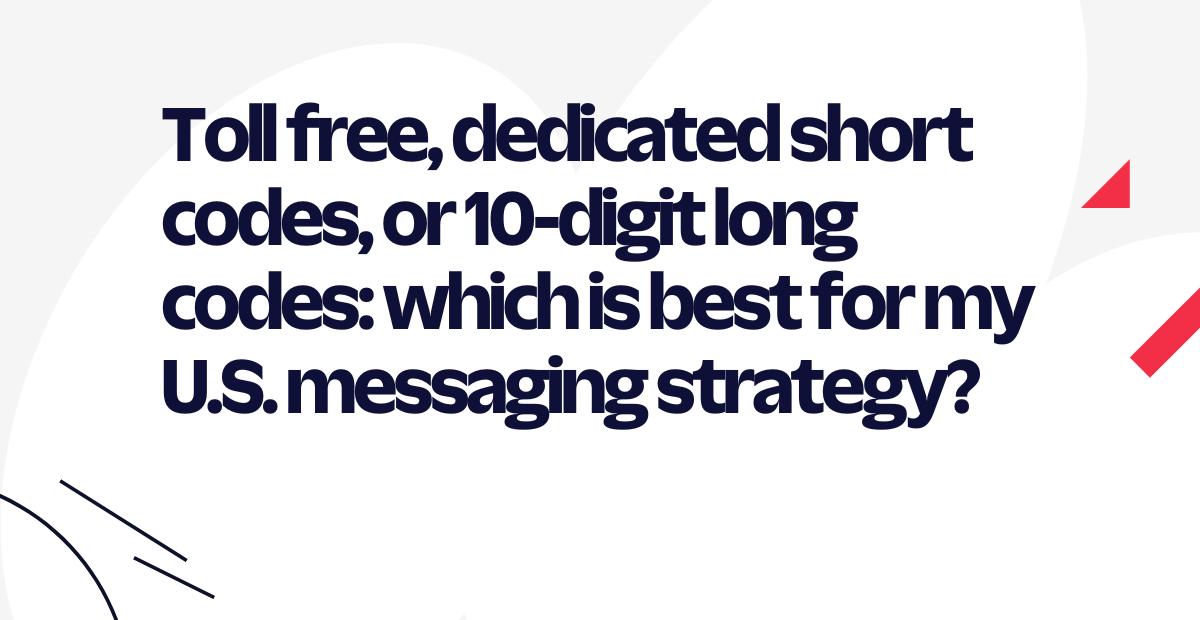Toll free, dedicated short codes, or 10-digit long codes: which is best for my U.S. messaging strategy?
Time to read:

For many businesses and brands, SMS is central to customer engagement. To make sure that remains the case, and it stays a trusted, high-engagement channel, carriers have implemented a series of know-your-customer initiatives across short codes, toll free, and now with the newest A2P 10DLC requirements with the added business benefits of increased reliability, security, and throughput.
Messaging remains the single most effective customer engagement channel, with an open rate of 98 percent. But between the new A2P 10DLC requirements and capabilities, and existing number types like short codes and toll-free, many businesses are reevaluating the best approach to reach customers via SMS.
Learning about and adjusting to these shifts will allow you to maintain SMS as the crowning jewel of your multichannel customer engagement strategy.
Adjusting your SMS strategy can be daunting, but with those challenges come long-term benefits too. And, the changes brought about by A2P 10DLC will ultimately create a better, safer, more trusted landscape for all businesses who reach customers via SMS.
To help you navigate this new landscape, we’ve created this guide to the current messaging options—toll free, dedicated short codes, and A2P 10DLC—with a brief look at their various benefits and limitations. With A2P 10DLC comes an opportunity to evaluate these options based on use cases and identity, not just cost and throughput, which we’ll explore below.
While this guide can serve as a starting point, there is no one-size-fits-all solution for the future of SMS and customer engagement; for more insight, read our other A2P 10DLC coverage or get in touch with the experts at our newly-launched Trust Hub.
Dedicated short codes
Short codes have long been a staple of A2P messaging, particularly because they are capable of handling high volumes of messages, allowing businesses to reach millions of subscribers with relative ease. The campaign approval process for short codes has also made it a reliable option with the highest deliverability per message.
Shared short codes, or codes shared across multiple brands, have created challenges with a steady increase in unwanted spam being reported. To increase transparency and trust in the SMS ecosystem, shared short codes are being phased out altogether. Those who previously used shared shortcodes for their messaging will either have to lease a dedicated short code, or switch to toll-free or A2P 10DLC numbers.
Dedicated short codes will retain their current functionalities, providing customers the highest throughput and deliverability. They continue to be best suited to urgent, high-volume notifications, like one-time passwords, fraud alerts, and emergency broadcasts.
They will continue to be the best option for customers who need to support high volume messaging and time-sensitive deliverability. Handset delivery receipts will provide the most granular delivery details across a messaging strategy. However, there are few dedicated short codes available, and they don’t have voice capabilities—making them an exclusive and expensive option not suited for highly conversational use cases.
Toll free
Dedicated toll free numbers provide one of the most flexible messaging options. Toll free has a straightforward implementation process and can also undergo a verification process similar to short codes and A2P 10DLC to improve deliverability.
These numbers are a simple, effective tool for application-to-person communications at a mid-high volume. They also offer the ability for voice calling and conversations, allowing you to create a seamless experience for customers.
In terms of speed and flexibility, toll free is a solid choice: they’re easy to provision and serve a variety of purposes. Many businesses already have toll free numbers at their disposal, which provides an easy opportunity to add SMS capabilities to your engagement strategy.
Local 10-digit long codes
Ten-digit long codes are an incredibly popular channel for business messaging, but these numbers weren’t created with application-to-person messaging in mind—a problem the A2P 10DLC changes are aimed at solving.
Getting up-and-running with a long code will now require completion of a verification process. To use long codes, businesses must now:
- Identify who they are to the carrier networks.
- Register what type of messages they are sending.
This process increases the barrier to entry, creating a trusted ecosystem by preventing spammers from abusing consumers. It also provides businesses with higher throughput, improved deliverability, and builds a channel for long-term customer engagement.
Long codes also offer your business the opportunity to create trusted localized experiences with area codes your customers know, making them an ideal option for person-to-person interactions.
We're here to support you
A2P 10DLC is helping pave the way for a more reliable and secure future in the messaging space, but each option has unique benefits and drawbacks to consider. Ultimately, what matters most is which will allow you to most effectively engage your customers and community.
Nothing is more important than maintaining the trust of customers—and we’re working to ensure our partners impacted by these changes can successfully navigate the transition process. If you want to get a better handle on what these changes mean for your business, get in touch with our team today.
Related Posts
Related Resources
Twilio Docs
From APIs to SDKs to sample apps
API reference documentation, SDKs, helper libraries, quickstarts, and tutorials for your language and platform.
Resource Center
The latest ebooks, industry reports, and webinars
Learn from customer engagement experts to improve your own communication.
Ahoy
Twilio's developer community hub
Best practices, code samples, and inspiration to build communications and digital engagement experiences.


